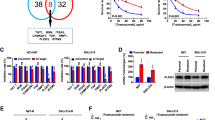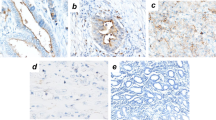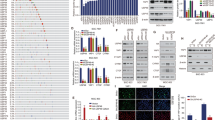Abstract
Human epidermal growth factor receptor-2 (HER-2) overexpression was closely associated with the tumor growth and invasion, we here aimed to investigate the mechanism of HER-2 mediation in the pathogenesis of gastric cancer (GC). We first detected the expression of HER-2 in GC cell line SGC-7901 and then examined the levels of nuclear factor-κB (NF-κB), matrix metalloproteinase-9 (MMP-9) and intercellular adhesion molecule-1 (ICAM-1) and the association between them by molecular methods. Statistical analysis was used to compare the significance. We further detected the possible molecular mechanism involved in their relationship in the SGC-7901 genesis. The MMP-9, NF-κB and secretory type (s-ICAM-1) levels were significantly greater in peripheral blood serum from SGC-7901 than healthy control GES-1 (P<0.01). ICAM-1, MMP-9 and NF-κB mRNA and protein levels were more highly expressed in SGC-7901 than healthy control GES-1. The expression levels of NF-κB, MMP-9 and ICAM-1 were positively related in GC cell line SGC-7901, which was HER-2 positive. The HER-2 positive SGC-7901 secreted more transforming growth factor beta 1 (TGF-β1) and resultantly activated MMP-9 to enhance s-ICAM-1 secretion and further studies showed that phosphatidylinositol-3 kinase (PI3K)/Akt/NF-κB signaling pathway was involved in GC pathogenesis. The GC cells that express the HER-2 oncogene spur the activation of NF-κB that can upregulate the expression of ICAM-1 and induce the expression of MMP-9, which hydrolyzes ICAM-1 into s-ICAM-1 to promote tumor immune escape. TGF-β1-induced PI3K/Akt/NF-κB signaling pathway was involved in the pathogenesis of GC and they could be a new target for cancer therapy. The GC cells that express the HER-2 oncogene spur the activation of NF-κB that can upregulate the expression of ICAM-1 and induce the expression of MMP-9, which hydrolyzes ICAM-1 into s-ICAM-1 to promote tumor immune escape. TGF-β1-induced PI3K/Akt/NF-κB signaling pathway was involved in the pathogenesis of GC and they could be a new target for cancer therapy.
This is a preview of subscription content, access via your institution
Access options
Subscribe to this journal
Receive 12 print issues and online access
$259.00 per year
only $21.58 per issue
Buy this article
- Purchase on Springer Link
- Instant access to full article PDF
Prices may be subject to local taxes which are calculated during checkout







Similar content being viewed by others
References
Chen J, Chen LJ, Zhou HC, Yang RB, Lu Y, Xia YL et al. Prognostic value of matrix metalloproteinase-9 in gastric cancer: a meta-analysis. Hepatogastroenterology 2014; 61: 518–524.
Yang Y, Bai ZG, Yin J, Wu GC, Zhang ZT . Role of c-Src activity in the regulation of gastric cancer cell migration. Oncol Rep 2014; 32: 45–49.
Li Y, Tan BB, Zhao Q, Fan LQ, Wang D, Liu Y et al. ZNF139 promotes tumor metastasis by increasing migration and invasion in human gastric cancer cells. Neoplasma 2014; 61: 291–298.
Yu SY, Li Y, Fan LQ, Zhao Q, Tan BB, Liu Y et al. Impact of Annexin A3 expression in gastric cancer cells. Neoplasma 2014; 61: 257–264.
Oo HZ, Sentani K, Sakamoto N, Anami K, Naito Y, Uraoka N et al. Overexpression of ZDHHC14 promotes migration and invasion of scirrhous type gastric cancer. Oncol Rep 2014; 32: 403–410.
Li XS, Xu Q, Fu XY, Luo WS . Heat shock protein 22 overexpression is associated with the progression and prognosis in gastric cancer. J Cancer Res Clin Oncol 2014; 140: 1305–1313.
Yang H, Wang B, Yan J, Wang T, Zhou XN, Wen HY et al. Toll-like receptor 2 promotes invasion by SGC-7901 human gastric carcinoma cells and is associated with gastric carcinoma metastasis. Ann Clin Lab Sci 2014; 44: 158–166.
Chang WJ, Du Y, Zhao X, Ma LY, Cao GW . Inflammation-related factors predicting prognosis of gastric cancer. World J Gastroenterol 2014; 20: 4586–4596.
Liu J, Liu Q, Wan Y, Zhao Z, Yu H, Luo H et al. Osteopontin promotes the progression of gastric cancer through the NF-κB pathway regulated by the MAPK and PI3K. Int J Oncol 2014; 45: 282–290.
Ojetti V, Persiani R, Cananzi FC, Sensi C, Piscaglia AC, Saulnier N et al. cDNA-microarray analysis as a new tool to predict lymph node metastasis in gastric cancer. World J Surg 2014; 38: 2058–2064.
Zhang J, Wang P, Zhu J, Wang W, Yin J, Zhang C et al. SPARC expression is negatively correlated with clinicopathological factors of gastric cancer and inhibits malignancy of gastric cancer cells. Oncol Rep 2014; 31: 2312–2320.
Bubnovskaya L, Kovelskaya A, Gumenyuk L, Ganusevich I, Mamontova L, Mikhailenko V et al. Disseminated tumor cells in bone marrow of gastric cancer patients: correlation with tumor hypoxia and clinical relevance. J Oncol 2014; 2014: 582140.
Jiang B, Li Z, Zhang W, Wang H, Zhi X, Feng J et al. miR-874 Inhibits cell proliferation, migration and invasion through targeting aquaporin-3 in gastric cancer. J Gastroenterol 2014; 49: 1011–1025.
Wen YG, Wang Q, Zhou CZ, Qiu GQ, Peng ZH, Tang HM et al. Mutation analysis of tumor suppressor gene PTEN in patients with gastric carcinomas and its impact on PI3K/AKT pathway. Oncol Rep 2010; 24: 89–95.
Kim YM, Kim IH, Nam TJ . Inhibition of AGS human gastric cancer cell invasion and proliferation by Capsosiphon fulvescens glycoprotein. Mol Med Rep 2013; 8: 11–16.
Kang D, Gong Y, Zhu Y, Li A, Dong N, Piao Y et al. The biological activity of H. pylori SlyD in vitro. Helicobacter 2013; 18: 347–355.
Zhang GE, Jin HL, Lin XK, Chen C, Liu XS, Zhang Q et al. Anti-tumor effects of mfn2 in gastric cancer. Int J Mol Sci 2013; 14: 13005–13021.
Peng CW, Wang LW, Fang M, Yang GF, Li Y, Pang DW et al. Combined features based on MT1-MMP expression, CD11b+immunocytes density and LNR predict clinical outcomes of gastric cancer. J Transl Med 2013; 11: 153.
Park SH, Hong H, Han YM, Kangwan N, Kim SJ, Kim EH et al. Nonsteroidal anti-inflammatory drugs (NSAID) sparing effects of glucosamine hydrochloride through N-glycosylation inhibition; strategy to rescue stomach from NSAID damage. J Physiol Pharmacol 2013; 64: 157–165.
Chen HJ, Lin CM, Lee CY, Shih NC, Amagaya S, Lin YC et al. Phenethyl isothiocyanate suppresses EGF-stimulated SAS human oral squamous carcinoma cell invasion by targeting EGF receptor signaling. Int J Oncol 2013; 43: 629–637.
Song W, Zhao C, Jiang R . Integrin-linked kinase silencing induces a S/G2/M phases cell cycle slowing and modulates metastasis-related genes in SGC7901 human gastric carcinoma cells. Tumori 2013; 99: 249–256.
Wang G, Wang W, Zhou J, Yang X . Correlation between telomerase activity and matrix metalloproteinases 2 expression in gastric cancer. Cancer Biomark 2013; 13: 21–28.
Ke P, Wu ZD, Wen HS, Ying MX, Long HC, Qing LG et al. Current evidence on associations between the MMP-7 (-181 A>G) polymorphism and digestive system cancer risk. Asian Pac J Cancer Prev 2013; 14: 2269–2272.
Liu QS, Zhang J, Liu M, Dong WG . Lentiviral-mediated miRNA against liver-intestine cadherin suppresses tumor growth and invasiveness of human gastric cancer. Cancer Sci 2010; 101: 1807–1812.
Emara M, Cheung PY, Grabowski K, Sawicki G, Wozniak M . Serum levels of matrix metalloproteinase-2 and -9 and conventional tumor markers (CEA and CA 19-9) in patients with colorectal and gastric cancers. Clin Chem Lab Med 2009; 47: 993–1000.
Buergy D, Fuchs T, Kambakamba P, Mudduluru G, Maurer G, Post S et al. Prognostic impact of extracellular matrix metalloprotease inducer: immunohistochemical analyses of colorectal tumors and immunocytochemical screening of disseminated tumor cells in bone marrow from patients with gastrointestinal cancer. Cancer 2009; 115: 4667–4678.
Li Y, Sun DL, Duan YN, Zhang XJ, Wang N, Zhou RM et al. Association of functional polymorphisms in MMPs genes with gastric cardia adenocarcinoma and esophageal squamous cell carcinoma in high incidence region of North China. Mol Biol Rep 2010; 37: 197–205.
Zhao FJ, Kang CS, Cui XW, Song XM, Liu J, Zhang QY et al. The relationship of MMP-9, VEGF and PCNA expressions and their clinical significance in gastric adenocarcinoma. Zhonghua Nei Ke Za Zhi 2009; 48: 114–117, Chinese.
Lukaszewicz-Zajac M, Mroczko B, Szmitkowski M . The significance of metalloproteinases and their inhibitors in gastric cancer. Postepy Hig Med Dosw (Online) 2009; 63: 258–265, Polish.
Adachi Y, Li R, Yamamoto H, Min Y, Piao W, Wang Y et al. Insulin-like growth factor-I receptor blockade reduces the invasiveness of gastrointestinal cancers via blocking production of matrilysin. Carcinogenesis 2009; 30: 1305–1313.
Vecchione L, Orditura M, Ciardiello F, De Vita F . Novel investigational drugs for gastric cancer. Expert Opin Investig Drugs 2009; 18: 945–955.
Du R, Xia L, Sun S, Lian Z, Zou X, Gao J et al. URG11 promotes gastric cancer growth and invasion by activation of beta-catenin signalling pathway. J Cell Mol Med 2010; 14: 621–635.
Kamata I, Ishikawa Y, Akishima-Fukasawa Y, Ito K, Akasaka Y, Uzuki M et al. Significance of lymphatic invasion and cancer invasion-related proteins on lymph node metastasis in gastric cancer. J Gastroenterol Hepatol 2009; 24: 1527–1533.
Peng TL, Chen J, Mao W, Song X, Chen MH . Aryl hydrocarbon receptor pathway activation enhances gastric cancer cell invasiveness likely through a c-Jun-dependent induction of matrix metalloproteinase-9. BMC Cell Biol 2009; 10: 27.
Nomura T, Kamio Y, Takasu N, Moriya T, Takeshita A, Mizutani M et al. Intrahepatic micrometastases around liver metastases from gastric cancer. J Hepatobiliary Pancreat Surg 2009; 16: 493–501.
Achyut BR, Ghoshal UC, Moorchung N, Mittal B . Transforming growth factor-B1 and matrix metalloproteinase-7 promoter variants induce risk for Helicobacter pylori-associated gastric precancerous lesions. DNA Cell Biol 2009; 28: 295–301.
Fu Y, Zhang Q, Kang C, Zhang J, Zhang K, Pu P et al. Inhibitory effects of adenovirus mediated Akt1 and PIK3R1 shRNA on the growth of malignant tumor cells in vitro and in vivo. Cancer Biol Ther 2009; 8: 1002–1009.
Author information
Authors and Affiliations
Corresponding author
Ethics declarations
Competing interests
The authors declare no conflict of interest.
Rights and permissions
About this article
Cite this article
Fu, Y., Gui, R. & Liu, J. HER-2-induced PI3K signaling pathway was involved in the pathogenesis of gastric cancer. Cancer Gene Ther 22, 145–153 (2015). https://doi.org/10.1038/cgt.2014.80
Received:
Revised:
Accepted:
Published:
Issue Date:
DOI: https://doi.org/10.1038/cgt.2014.80



